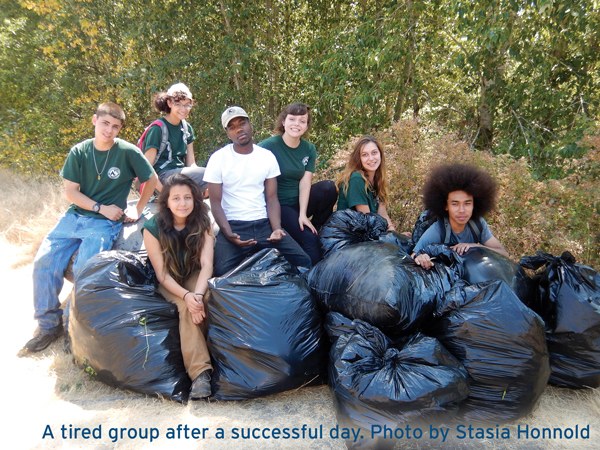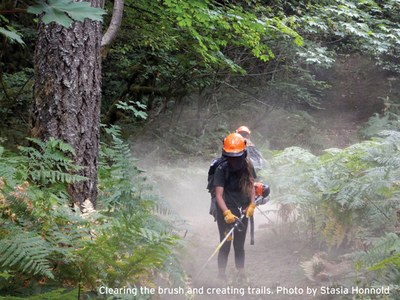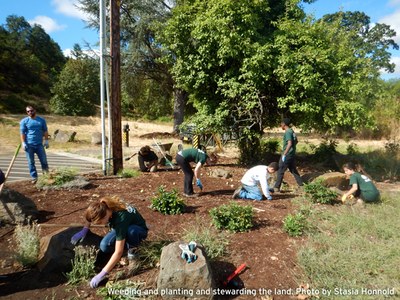
by Stasia Honnold, youth and stewardship coordinator
It’s pushing 95 degrees in Portland, and I’m biking home in the uncharacteristic and unforgiving sunshine, squinting even behind my sunglasses. It’s been over 90 all week.
And all week I have spent all day positively baking in ultraviolet radiation, my long pants, long sleeves, work boots, and leather gloves clinging to streams of sweat all over my body — sweat and sunscreen and dirt mingling into one body-covering sludge of work-grime.
But however disgusting I feel, it’s not so bad. I work hard, but probably not so hard as my crew of eight “at-risk” young adults — a designation I hate — who are out here doing conservation work. For most of them, it’s their first job experience and first time really immersed in the outdoors. They’re participating in a program that helps youth earn their GEDs and get back on track for school or career; part of that program is an opportunity to apply for a job like this one. Hired youth are paid to carry out environmental work in collaboration with our regional partners, getting a real-world line of experience for their resumes as well as mentorship as to how to be successful in a job. Many of them would probably not spend much time outside except for this paid experience, but with it, they spend up to 30 hours per week up to their elbows in nature.
 They’re not, mind you, partaking in the fun outdoor activities that you or I may think about when we think about nature. This crew of mine? They pull scotch broom, English ivy, and other nuisance plants, wrestling with the brambles and stinging insects. They build fences, bridges and trails and have the blisters to prove it; they monitor oak habitat or amphibian egg masses; they collect seeds from native plants and re-pot the little seedlings. They mulch, they count, they weed-whack, they haul — and through it all, imperceptibly, they learn. Not just about how to be responsible and get along in the working world, but about nature and their impact on it. The seasons. The cycles. The animals, the plants. All of the “behind the scenes stuff,” says one of my crew, that “you don’t ever think about until you have to do it. Like trail maintenance, decommissioning trails, cleaning campsites, putting in parking barriers — none of that stuff magically gets done.”
They’re not, mind you, partaking in the fun outdoor activities that you or I may think about when we think about nature. This crew of mine? They pull scotch broom, English ivy, and other nuisance plants, wrestling with the brambles and stinging insects. They build fences, bridges and trails and have the blisters to prove it; they monitor oak habitat or amphibian egg masses; they collect seeds from native plants and re-pot the little seedlings. They mulch, they count, they weed-whack, they haul — and through it all, imperceptibly, they learn. Not just about how to be responsible and get along in the working world, but about nature and their impact on it. The seasons. The cycles. The animals, the plants. All of the “behind the scenes stuff,” says one of my crew, that “you don’t ever think about until you have to do it. Like trail maintenance, decommissioning trails, cleaning campsites, putting in parking barriers — none of that stuff magically gets done.”
With their work, they get closer to the environment and become better stewards for our natural lands than they — or many people who simply stop listening after the “at risk” label — would have ever thought possible.
We talk a lot these days about nature deficit in children. About how youth spend more time in front of screens than ever before, or how people don’t even know where parks in their neighborhoods are, much less parks in their states or their country. Often, the response to those kinds of dire figures is to create ever more one-off recreational programming for kids. We create fun excursions into nature that “connect” children to their natural environment and, purportedly, launch them down pathways to future stewardship of our region’s green spaces. And while I totally agree that experience in nature is essential for any of us, and while I bet it does even change kids’ perspectives on the outdoors (especially for those who haven’t had much previous access), I question its lasting impact. A one-time experience does not a steward make. Stewardship takes time and investment, and that’s where programs like mine excel.
The eight young adults in my crew might not spend much time doing the things we think of as the outdoor pursuits — hiking, camping, or the other activities likely to be included in one-off experiences — that lead people to care about nature. But through the honest work they do, they learn what true stewardship is. Not what recreation is, but stewardship, the kind of thing that takes stubbornness and long-term investment, the kind of thing where it’s not your personal experience that matters but how you can use your experience to make the world better for everyone.
At the conclusion of last season, my crew members spoke, eloquently, about how this job has impacted not only their lives but how they see the world. “I know that other people at work depend on me,” says one. “That I am not a piece of trash like I thought I was. I’m a fun-loving, hard-working, and curious person, eager to learn and to help others. And that I love, love, love the outdoors. I wouldn’t be myself without it.” Many of them speak to ecological knowledge they’d have never guessed they would have: “I like that now when I’m out in the forest I’m not like, oh, I’m just surrounded by plants, I know what the plants are around me or if I see insects I won’t just think of them as bugs, I’ll know what type they are. And you kind of develop respect for the plants and animals. Because it’s like you’re in their home.” They notice the exotic weeds that grow in their neighborhoods; they hear the bird chorus that still exists in the morning, even outside their urban apartments. They notice tracks and signs left behind by a variety of animals, and they can tell what animals they were. In short, they are more connected to nature than they ever could have guessed they would be, simply by virtue of having done good, hard work, outside, weeks and months at a time. And by the same token, they’ve become better workers, more employable, more knowledgeable, more responsible then they were when we hired them.
 After we put away our tools every evening, debrief the day, and plan for the next, I send my crew home. I take off my boots, change out of my work clothes, and throw myself back into the sunshine for the 15 miles it takes to bike home. As I pedal through the world, a car-free choice that for me is also about stewardship, I can’t help but think how much working with “at risk” youth has bettered me as well. Despite the fact that I’ve been working with teens who are considered “at risk” for my entire professional career, when I mention it I still sometimes get sympathetic glances, the well-meaning but ultimately dismissive click of the tongue that says “thank goodness it’s you and not me working with those hoodlums.” But those “hoodlums,” the youth who for whatever reason have slipped through one too many cracks, are just like anyone else in the world, and they teach me worlds.
After we put away our tools every evening, debrief the day, and plan for the next, I send my crew home. I take off my boots, change out of my work clothes, and throw myself back into the sunshine for the 15 miles it takes to bike home. As I pedal through the world, a car-free choice that for me is also about stewardship, I can’t help but think how much working with “at risk” youth has bettered me as well. Despite the fact that I’ve been working with teens who are considered “at risk” for my entire professional career, when I mention it I still sometimes get sympathetic glances, the well-meaning but ultimately dismissive click of the tongue that says “thank goodness it’s you and not me working with those hoodlums.” But those “hoodlums,” the youth who for whatever reason have slipped through one too many cracks, are just like anyone else in the world, and they teach me worlds.
They teach me that sometimes one chance isn’t enough. That people, like the environment, need patience and tending. They teach me that loving is a skill too, one that we learn through example, often poorly, but it’s a skill that can be taught and re-taught. And though it’s important to teach kids to love nature, my crew knows first hand that loving something doesn’t necessarily mean you act in its best interest. And they know that stewardship doesn’t come only of loving the places around you, but of learning how to take care of them. Stewardship is about understanding how everything we do impacts our world and working, sometimes tirelessly and thanklessly and doggedly, to make sure it survives beyond us. Sometimes it’s the gritty, overlooked, underestimated young adults of the world — the ones I feel so fortunate to be able to work with, the ones who have had and lost one chance after another, or who have never had a chance at all — who understand that best.
This article originally appeared in our Sept/Oct 2015 issue of Mountaineer magazine. To view the original article in magazine form and read more stories from our publication, click here.
Add a comment
Log in to add comments.Love it. There's so much potential in this type of work that the social sciences have yet to realize.
Hi! This is an incredible article. Bringing youth to conservation jobs should be a more widely spread strategy for improving communities that under-appreciate and under-utilize their outdoor resources.
We currently have the same project in our climbing group Climbing Borders in Mexico. There's absolutely no notion of conservancy - the mountains are filled with quarries, the air thick with dust and pollution, the streams and trails and roads lined with styrofoam and bottles. Our kids, as young as 4 and as old as 18, have a rad time picking up trash and establishing paths with rocks and rock art.
Mountaineers, thank you so much for this article. Stasia, great job doing what you're doing. People don't easily see the long-term value in teaching troubled youth to appreciate the therapeutic great outdoors through paid conservancy.
You all rock.
 Suzanne Gerber
Suzanne Gerber